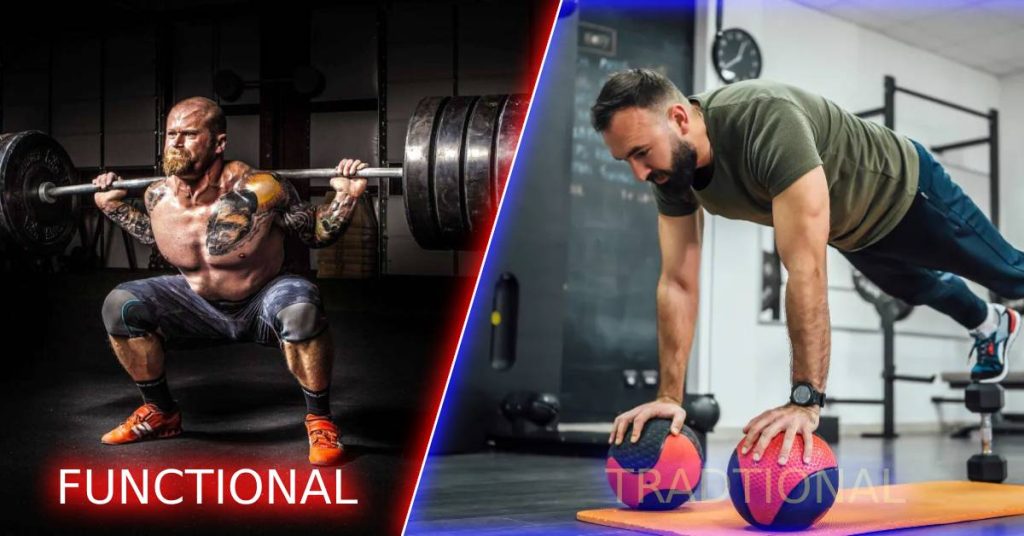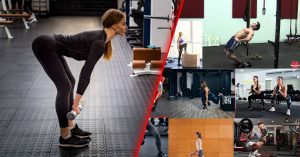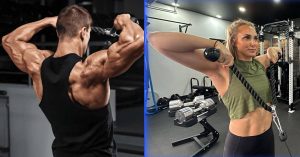In the realm of fitness, a riveting saga unfolds as traditional training and functional strength training stand at the crossroads, each promising a unique journey to peak health and vitality. As we embark on this odyssey, let’s delve deeper, exploring the essence and core principles of these distinct yet interconnected training philosophies.
Table of contents
MORE keyboard_double_arrow_down LESS keyboard_double_arrow_up
What is Traditional Training?
Instead of training your whole body at once, traditional strength training focuses on specific muscles, like a builder crafting a house brick by brick. These exercises use weights or machines to push these muscles to their limits, building both size (hypertrophy) and strength.
This approach lets you:
- Target specific areas for growth or correction.
- Track progress easily by focusing on one muscle at a time.
- Experience a satisfying workout pump by training each muscle to exhaustion.
- Improve your posture and stability by strengthening your muscles and bones.
- This type of training, often seen in “leg days” at the gym, is popular for bodybuilders and those aiming for defined muscles or targeted strength gains.
What is Functional Strength Training?
While all strength training improves your body’s ability to handle challenges, functional training goes beyond just building muscle. It’s about training your body as a connected unit to move more naturally and efficiently in everyday life.
Like a builder crafting a house, it uses compound movements that engage multiple muscle groups at once. Think squats, lunges, deadlifts, and pull-ups. These mimic real-life actions like bending, lifting, and running.
Functional training has its roots in rehabilitation. Physical therapists use these movements to help people recover from injuries and regain daily function. Functional strength training applies this principle to everyone, aiming to improve everyday activities like carrying groceries, climbing stairs, and bending down.
The reason why this method of training stands out is because:
- More efficient workouts: Compound movements work many muscles at once, saving you time.
- Improved everyday life: You’ll be able to move with more ease and confidence.
- Reduced injury risk: Better form and mobility lead to safer movement.
- Overall fitness boost: Build lean muscle, improve balance, and enhance endurance.
Functional training can be done with various tools:
- Free weights
- Resistance bands
- Cables
- Even your bodyweight!
Merging Functional Strength Training and Traditional Strength
Merging the precision of traditional exercises with the dynamic versatility of functional movements creates a comprehensive fitness regimen. This synergy not only enhances muscle growth but also ensures agility and practical strength for everyday tasks.
Combining functional strength training vs traditional strength training offers a holistic approach to fitness that maximizes benefits. Here’s a sneak peek into how this can transform your training:
- Start with functional movements to warm up and prime your muscles
- Follow up with traditional strength exercises for targeted muscle building
- Incorporate variety to prevent plateaus and keep your body guessing
Functional Strength Training vs Traditional Strength Training
When we delve into the worlds of functional strength training vs traditional strength training, we uncover a rich tapestry of contrast and complement. Traditional strength training, with its focus on isolating muscle groups, provides a structured approach to building muscle mass and power.
This method shines in the gym, where machines and free weights become the tools for sculpting the body.
On the flip side, functional training emerges as a dynamic force. It prioritizes movements that mirror the complexities of daily life and sports. This approach champions adaptability, ensuring that fitness transcends gym walls and weaves seamlessly into the fabric of everyday activities.
Pros and Cons: A Balanced Perspective
Traditional Strength Training
Pros:
- Enhances muscle size significantly
- Improves bone density, reducing the risk of osteoporosis
- Increases resting metabolic rate, aiding in weight management
Cons:
- May not directly improve functional capabilities in daily life
- Could lead to overdevelopment in some muscle groups, potentially causing imbalances
Functional Training
Pros:
- Boosts balance and coordination, vital for daily tasks
- Enhances overall performance in a wide range of activities
- Requires minimal equipment, making it accessible and versatile
Cons:
- Might not lead to the same level of muscle hypertrophy as traditional training
- Requires careful attention to form to avoid injury due to the complexity of movements
Which One Should I Choose? Functional Strength Training or Traditional Training?
Experts Opinions on Traditional vs Functional Strength Training
When it comes to the debate between functional strength training and traditional training, experts have varying opinions on which is better.
One expert who supports functional strength training is Dr. Juan Carlos Santana, a renowned strength and conditioning coach with a Doctorate in Fitness and Health Promotion. He emphasizes the importance of functional movements in his approach to training, advocating for exercises that translate to real-life activities.
Another advocate for functional strength training is Dr. Stuart McGill, a professor emeritus at the University of Waterloo who specializes in spine biomechanics. He states that it’s important to build a strong core through functional movements.
On the other hand, Dr. Brad Schoenfeld, an internationally renowned fitness expert with a Ph.D. in exercise science has conducted extensive research on resistance training. Based on his research he states that traditional training methods are effective when it comes to hypertrophy (muscle growth) and strength gains.
Furthermore, Dr. Wayne Westcott, a fitness researcher and author with a Ph.D. in physical education has written extensively about the benefits of traditional resistance training for improving muscular strength, endurance, and overall physical fitness.
So, Which One Should I Choose?
The journey toward selecting between traditional strength and functional training is deeply personal, hinging on your unique fitness goals, lifestyle, and preferences.
Are you chasing the dream of monumental muscle mass and a bodybuilder’s physique? Traditional strength training is your ally. Or, do you aspire to a versatile strength that supports your daily life and athletic endeavors? Then, functional training beckons.
Final Thoughts
Fitness is not a one-size-fits-all journey. It’s a personal odyssey filled with discovery, growth, and the relentless pursuit of health. Whether you’re lifting weights in a gym or sprinting through the park, the true measure of your strength is how you use it to live a fuller, more vibrant life.
By embracing both traditional strength and functional training, you can discover a path that resonates with your aspirations and lifestyle. Remember, the true essence of strength transcends the gym; it empowers us to lead fulfilling lives, brimming with vitality and resilience.
Key Points
- Traditional strength training focuses on isolated muscle groups, building size and strength with machines and weights. Good for targeted muscle growth and defined physique.
- Functional Training mimics everyday movements, engaging multiple muscle groups at once. Improves daily life activities, balance, and injury prevention.
- Benefits of functional training include more efficient workouts, improved everyday life, reduced injury risk, overall fitness boost.
- Benefits of traditional training include significant muscle growth, increased bone density, and higher resting metabolic rate.
- Combining them offers a holistic approach, maximizing muscle growth, functional ability, and overall health.
- Start with functional movements for warm-up, follow with traditional exercises for targeted building.
- Traditional Training shines in the gym, Functional Training excels in daily life application.
- Choosing the right method depends on your individual goals, lifestyle, and preferences.
FAQs
Can I combine traditional strength and functional training?
Absolutely! Merging both can offer a holistic workout that maximizes muscle growth, functional ability, and overall health.
Is functional training suitable for beginners?
Yes, it’s highly adaptable and can be tailored to any fitness level, focusing on natural movements and body mechanics.

ABOUT THE AUTHOR
Follow Valen Steven for a dose of fitness enthusiasm, evidence-based advice, and a roadmap to achieving your health and wellness goals.
Subscribe to our Newsletter
Dive into a world of fitness and wellness with our exclusive newsletter! Sign up now and receive weekly power-packs of fitness wisdom




